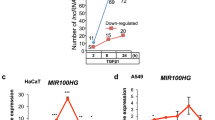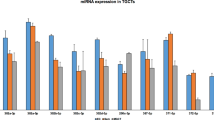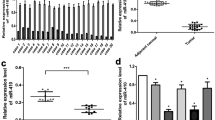Abstract
In the testicular cancer cell line, NT2, we previously demonstrated that differentially methylated regions were located in introns or intergenic regions, and postulated these might regulate non-coding RNAs. Three microRNAs and three small nucleolar RNAs were differentially methylated; one, miR-199a, was associated with the progression and prognosis of gastric and ovarian cancers. In this report we document, by epigenomic profiling of testicular tissue, that miR-199a is transcribed as antisense of dynamin 3 (chromosome 1q24.3), and hypermethylation of this region is correlated with miR-199a-5p/3p repression and tumor malignancy. Re-expression of miR-199a in testicular cancer cells led to suppression of cell growth, cancer migration, invasion and metastasis. The miR-199a-5p, one of two mature miRNA species derived from miR-199a, is associated with tumor malignancy. We further identified the embryonal carcinoma antigen podocalyxin-like protein 1 (PODXL), an anti-adhesive protein expressed in aggressive tumors, as a target of miR-199a-5p. We demonstrated PODXL is overexpressed in malignant testicular tumor, and cellular depletion of PODXL resulted in suppression of cancer invasion. The inverse relationship between PODXL and miR-199a-5p expression suggests PODXL is a downstream effector mediating the action of miR199a-5p. This report identifies DNA methylation, miR-199a dysregulation and PODXL as critical factors in tumor malignancy.
This is a preview of subscription content, access via your institution
Access options
Subscribe to this journal
Receive 50 print issues and online access
$259.00 per year
only $5.18 per issue
Buy this article
- Purchase on Springer Link
- Instant access to full article PDF
Prices may be subject to local taxes which are calculated during checkout






Similar content being viewed by others

References
Aleman A, Cebrian V, Alvarez M, Lopez V, Orenes E, Lopez-Serra L et al. (2008). Identification of PMF1 methylation in association with bladder cancer progression. Clin Cancer Res 14: 8236–8243.
Andrews PW, Damjanov I, Simon D, Banting GS, Carlin C, Dracopoli NC et al. (1984). Pluripotent embryonal carcinoma clones derived from the human teratocarcinoma cell line Tera-2. Differentiation in vivo and in vitro. Lab Invest 50: 147–162.
Casey G, Neville PJ, Liu X, Plummer SJ, Cicek MS, Krumroy LM et al. (2006). Podocalyxin variants and risk of prostate cancer and tumor aggressiveness. Hum Mol Genet 15: 735–741.
Chakrabarty A, Tranguch S, Daikoku T, Jensen K, Furneaux H, Dey SK . (2007). MicroRNA regulation of cyclooxygenase-2 during embryo implantation. Proc Natl Acad Sci USA 104: 15144–15149.
Chen R, Alvero AB, Silasi DA, Kelly MG, Fest S, Visintin I et al. (2008). Regulation of IKKbeta by miR-199a affects NF-kappaB activity in ovarian cancer cells. Oncogene 27: 4712–4723.
Cheung HH, Lee TL, Davis AJ, Taft DH, Rennert OM, Chan WY . (2010). Genome-wide DNA methylation profiling reveals novel epigenetically regulated genes and non-coding RNAs in human testicular cancer. Br J Cancer 102: 419–427.
Cheung HH, Lee TL, Rennert OM, Chan WY . (2009). DNA methylation of cancer genome. Birth Defects Res C Embryo Today 87: 335–350.
Eads CA, Danenberg KD, Kawakami K, Saltz LB, Blake C, Shibata D et al. (2000). MethyLight: a high-throughput assay to measure DNA methylation. Nucleic Acids Res 28: E32.
Esquela-Kerscher A, Slack FJ . (2006). Oncomirs—microRNAs with a role in cancer. Nat Rev Cancer 6: 259–269.
Fornari F, Milazzo M, Chieco P, Negrini M, Calin GA, Grazi GL et al. (2010). MiR-199a-3p regulates mTOR and c-Met to influence the doxorubicin sensitivity of human hepatocarcinoma cells. Cancer Res 70: 5184–5193.
Friedman LM, Dror AA, Mor E, Tenne T, Toren G, Satoh T et al. (2009). MicroRNAs are essential for development and function of inner ear hair cells in vertebrates. Proc Natl Acad Sci USA 106: 7915–7920.
Godwin JG, Ge X, Stephan K, Jurisch A, Tullius SG, Iacomini J . (2010). Identification of a microRNA signature of renal ischemia reperfusion injury. Proc Natl Acad Sci USA 107: 14339–14344.
Hayatsu N, Kaneko MK, Mishima K, Nishikawa R, Matsutani M, Price JE et al. (2008). Podocalyxin expression in malignant astrocytic tumors. Biochem Biophys Res Commun 374: 394–398.
He L, Hannon GJ . (2004). MicroRNAs: small RNAs with a big role in gene regulation. Nat Rev Genet 5: 522–531.
Huang Q, Gumireddy K, Schrier M, le Sage C, Nagel R, Nair S et al. (2008). The microRNAs miR-373 and miR-520c promote tumour invasion and metastasis. Nat Cell Biol 10: 202–210.
Ichimi T, Enokida H, Okuno Y, Kunimoto R, Chiyomaru T, Kawamoto K et al. (2009). Identification of novel microRNA targets based on microRNA signatures in bladder cancer. Int J Cancer 125: 345–352.
Iorio MV, Visone R, Di Leva G, Donati V, Petrocca F, Casalini P et al. (2007). MicroRNA signatures in human ovarian cancer. Cancer Res 67: 8699–8707.
Jones PA, Takai D . (2001). The role of DNA methylation in mammalian epigenetics. Science 293: 1068–1070.
Kim S, Lee UJ, Kim MN, Lee EJ, Kim JY, Lee MY et al. (2008). MicroRNA miR-199a* regulates the MET proto-oncogene and the downstream extracellular signal-regulated kinase 2 (ERK2). J Biol Chem 283: 18158–18166.
Koch LK, Zhou H, Ellinger J, Biermann K, Holler T, von Rucker A et al. (2008). Stem cell marker expression in small cell lung carcinoma and developing lung tissue. Hum Pathol 39: 1597–1605.
Lee DY, Shatseva T, Jeyapalan Z, Du WW, Deng Z, Yang BB . (2009). A 3′-untranslated region (3′UTR) induces organ adhesion by regulating miR-199a* functions. PLoS One 4: e4527.
Lee JW, Choi CH, Choi JJ, Park YA, Kim SJ, Hwang SY et al. (2008). Altered MicroRNA expression in cervical carcinomas. Clin Cancer Res 14: 2535–2542.
Li LC, Zhao H, Nakajima K, Oh BR, Ribeiro Filho LA, Carroll P et al. (2001). Methylation of the E-cadherin gene promoter correlates with progression of prostate cancer. J Urol 166: 705–709.
Li Y, Tabatabai ZL, Lee TL, Hatakeyama S, Ohyama C, Chan WY et al. (2007). The Y-encoded TSPY protein: a significant marker potentially plays a role in the pathogenesis of testicular germ cell tumors. Hum Pathol 38: 1470–1481.
Lin EA, Kong L, Bai XH, Luan Y, Liu CJ . (2009). miR-199a, a bone morphogenic protein 2-responsive MicroRNA, regulates chondrogenesis via direct targeting to Smad1. J Biol Chem 284: 11326–11335.
Lujambio A, Calin GA, Villanueva A, Ropero S, Sanchez-Cespedes M, Blanco D et al. (2008). A microRNA DNA methylation signature for human cancer metastasis. Proc Natl Acad Sci USA 105: 13556–13561.
Nam EJ, Yoon H, Kim SW, Kim H, Kim YT, Kim JH et al. (2008). MicroRNA expression profiles in serous ovarian carcinoma. Clin Cancer Res 14: 2690–2695.
Netto GJ, Nakai Y, Nakayama M, Jadallah S, Toubaji A, Nonomura N et al. (2008). Global DNA hypomethylation in intratubular germ cell neoplasia and seminoma, but not in nonseminomatous male germ cell tumors. Mod Pathol 21: 1337–1344.
Pang AL, Peacock S, Johnson W, Bear DH, Rennert OM, Chan WY . (2009). Cloning, characterization, and expression analysis of the novel acetyltransferase retrogene Ard1b in the mouse. Biol Reprod 81: 302–309.
Peltier HJ, Latham GJ . (2008). Normalization of microRNA expression levels in quantitative RT-PCR assays: identification of suitable reference RNA targets in normal and cancerous human solid tissues. RNA 14: 844–852.
Rane S, He M, Sayed D, Vashistha H, Malhotra A, Sadoshima J et al. (2009). Downregulation of miR-199a derepresses hypoxia-inducible factor-1alpha and Sirtuin 1 and recapitulates hypoxia preconditioning in cardiac myocytes. Circ Res 104: 879–886.
Sahai E . (2005). Mechanisms of cancer cell invasion. Curr Opin Genet Dev 15: 87–96.
Santhakumar D, Forster T, Laqtom NN, Fragkoudis R, Dickinson P, Abreu-Goodger C et al. (2010). Combined agonist-antagonist genome-wide functional screening identifies broadly active antiviral microRNAs. Proc Natl Acad Sci USA 107: 13830–13835.
Schopperle WM, Kershaw DB, DeWolf WC . (2003). Human embryonal carcinoma tumor antigen, Gp200/GCTM-2, is podocalyxin. Biochem Biophys Res Commun 300: 285–290.
Singal R, Ferris R, Little JA, Wang SZ, Ginder GD . (1997). Methylation of the minimal promoter of an embryonic globin gene silences transcription in primary erythroid cells. Proc Natl Acad Sci USA 94: 13724–13729.
Smiraglia DJ, Szymanska J, Kraggerud SM, Lothe RA, Peltomaki P, Plass C . (2002). Distinct epigenetic phenotypes in seminomatous and nonseminomatous testicular germ cell tumors. Oncogene 21: 3909–3916.
Somasiri A, Nielsen JS, Makretsov N, McCoy ML, Prentice L, Gilks CB et al. (2004). Overexpression of the anti-adhesin podocalyxin is an independent predictor of breast cancer progression. Cancer Res 64: 5068–5073.
Takeda T, Go WY, Orlando RA, Farquhar MG . (2000). Expression of podocalyxin inhibits cell-cell adhesion and modifies junctional properties in Madin-Darby canine kidney cells. Mol Biol Cell 11: 3219–3232.
Tsai WC, Hsu PW, Lai TC, Chau GY, Lin CW, Chen CM et al. (2009). MicroRNA-122, a tumor suppressor microRNA that regulates intrahepatic metastasis of hepatocellular carcinoma. Hepatology 49: 1571–1582.
Tsai ZY, Singh S, Yu SL, Kao LP, Chen BZ, Ho BC et al. (2010). Identification of microRNAs regulated by activin A in human embryonic stem cells. J Cell Biochem 109: 93–102.
Ueda T, Volinia S, Okumura H, Shimizu M, Taccioli C, Rossi S et al. (2009). Relation between microRNA expression and progression and prognosis of gastric cancer: a microRNA expression analysis. Lancet Oncol 11: 136–146.
Watts GS, Futscher BW, Holtan N, Degeest K, Domann FE, Rose SL . (2008). DNA methylation changes in ovarian cancer are cumulative with disease progression and identify tumor stage. BMC Med Genomics 1: 47.
Worley LA, Long MD, Onken MD, Harbour JW . (2008). Micro-RNAs associated with metastasis in uveal melanoma identified by multiplexed microarray profiling. Melanoma Res 18: 184–190.
Yin G, Chen R, Alvero AB, Fu HH, Holmberg J, Glackin C et al. (2010). TWISTing stemness, inflammation and proliferation of epithelial ovarian cancer cells through MIR199A2/214. Oncogene 29: 3545–3553.
Zhu S, Wu H, Wu F, Nie D, Sheng S, Mo YY . (2008). MicroRNA-21 targets tumor suppressor genes in invasion and metastasis. Cell Res 18: 350–359.
Acknowledgements
We thank Dr Yun-Fai Chris Lau for providing the 833K cell line. This research was supported in part by the Intramural Research Program of the National Institutes of Health (NIH), Eunice Kennedy Shriver National Institute of Child Health and Human Development and the Chinese University of Hong Kong.
Author information
Authors and Affiliations
Corresponding author
Ethics declarations
Competing interests
The authors declare no conflict of interest.
Additional information
Supplementary Information accompanies the paper on the Oncogene website
Supplementary information
Rights and permissions
About this article
Cite this article
Cheung, HH., Davis, A., Lee, TL. et al. Methylation of an intronic region regulates miR-199a in testicular tumor malignancy. Oncogene 30, 3404–3415 (2011). https://doi.org/10.1038/onc.2011.60
Received:
Revised:
Accepted:
Published:
Issue Date:
DOI: https://doi.org/10.1038/onc.2011.60
Keywords
This article is cited by
-
Gene body methylation in cancer: molecular mechanisms and clinical applications
Clinical Epigenetics (2022)
-
Demethylation by low-dose 5-aza-2′-deoxycytidine impairs 3D melanoma invasion partially through miR-199a-3p expression revealing the role of this miR in melanoma
Clinical Epigenetics (2019)
-
Testicular germ cell tumor: a comprehensive review
Cellular and Molecular Life Sciences (2019)
-
MiR-29 silencing modulates the expression of target genes related to proliferation, apoptosis and methylation in Burkitt lymphoma cells
Journal of Cancer Research and Clinical Oncology (2018)
-
EMT and tumor metastasis
Clinical and Translational Medicine (2015)


